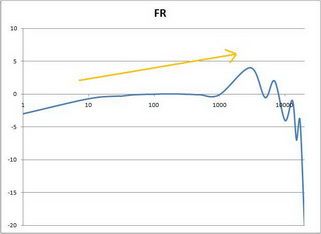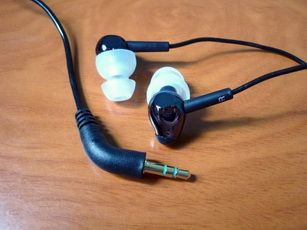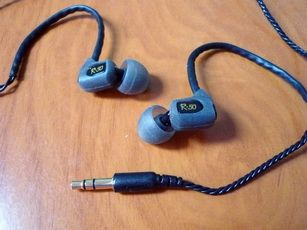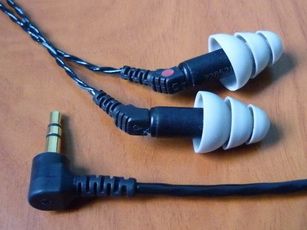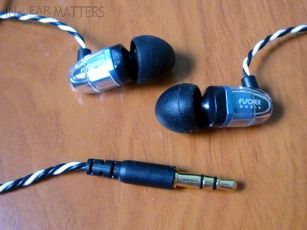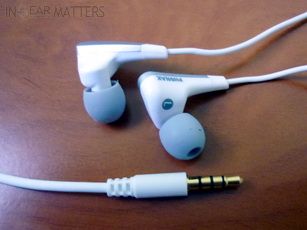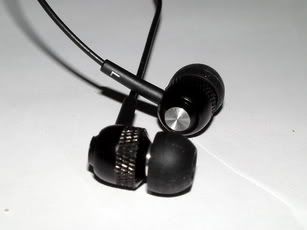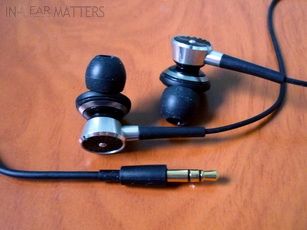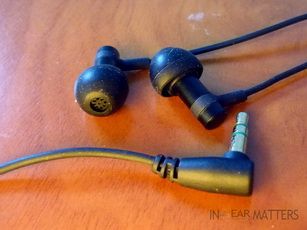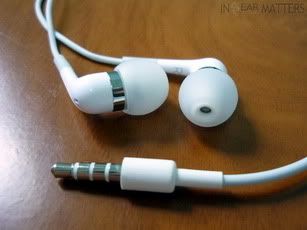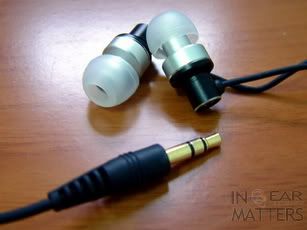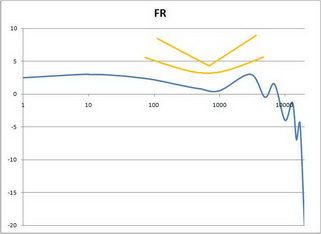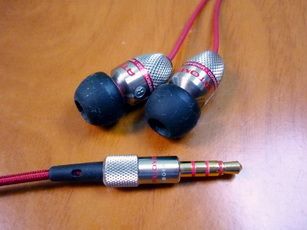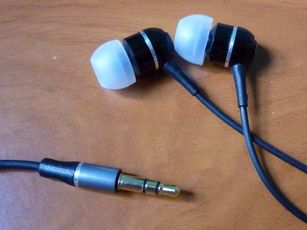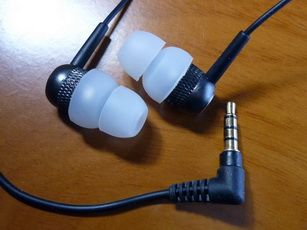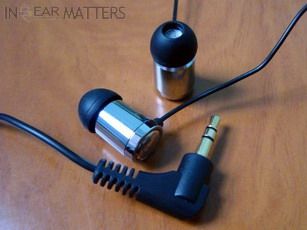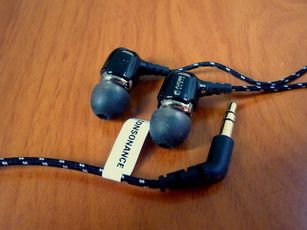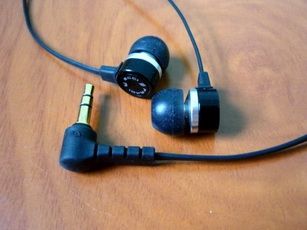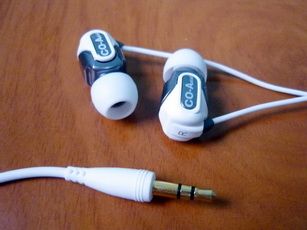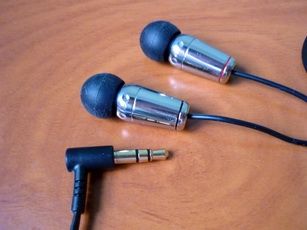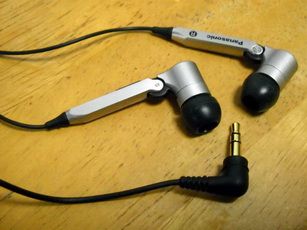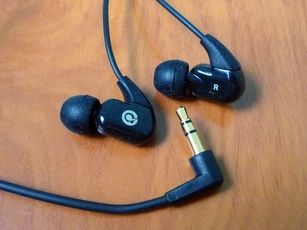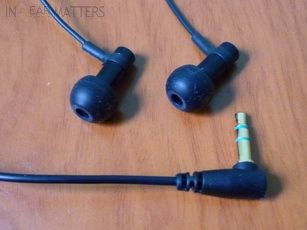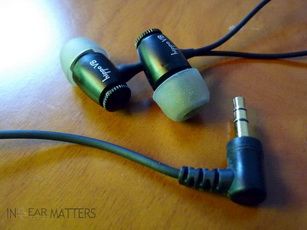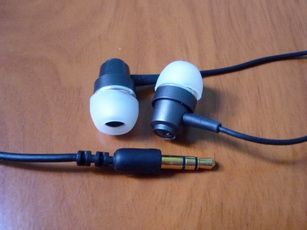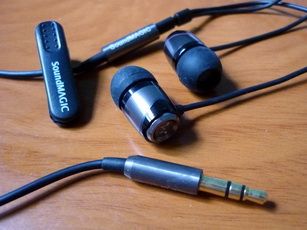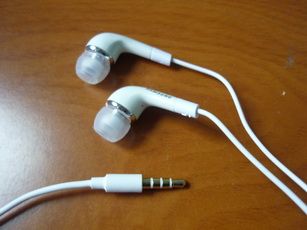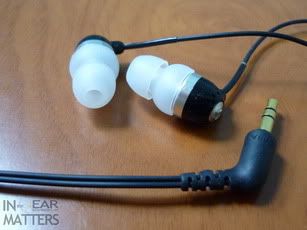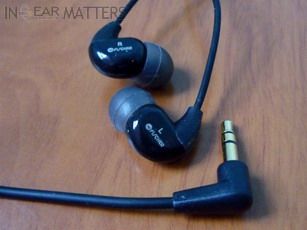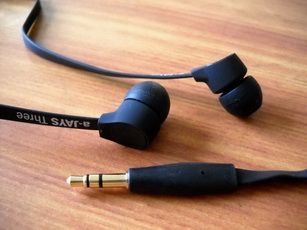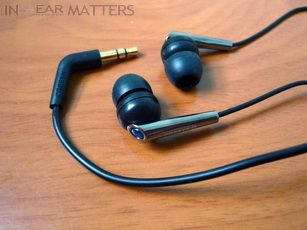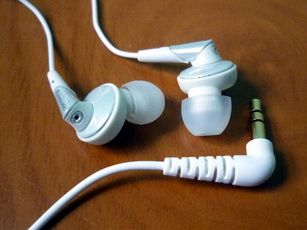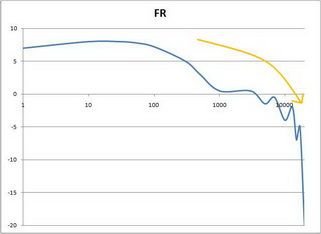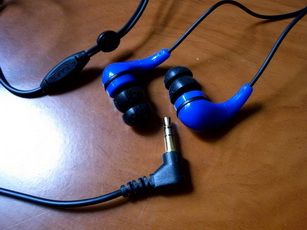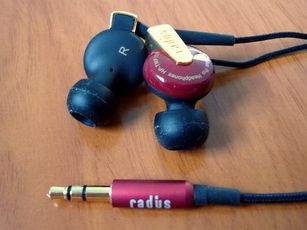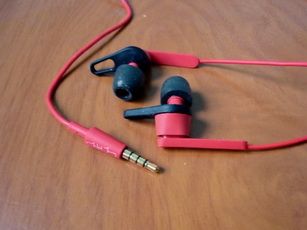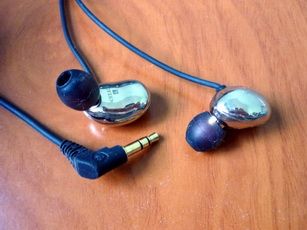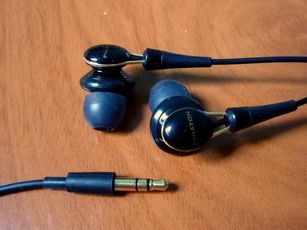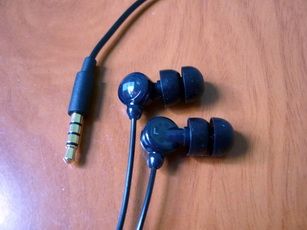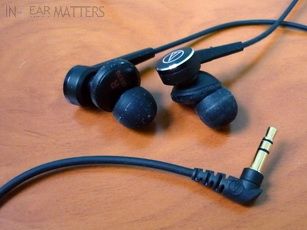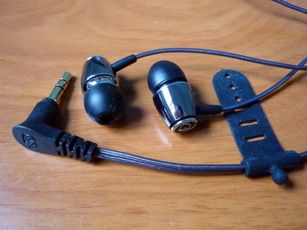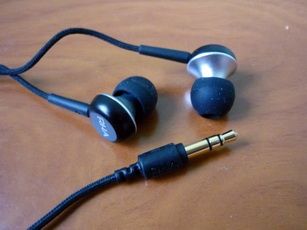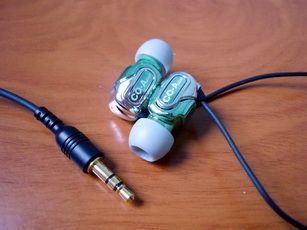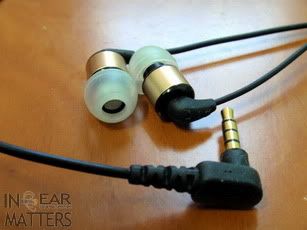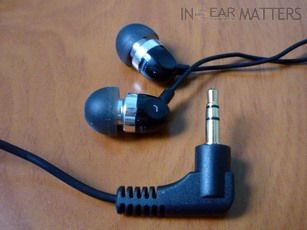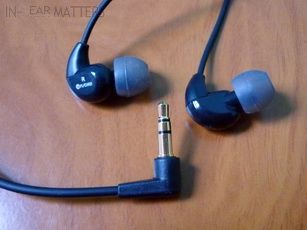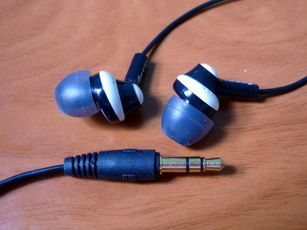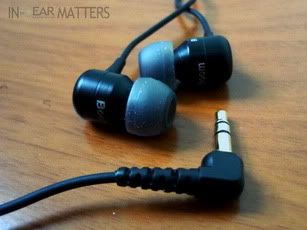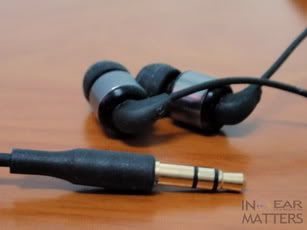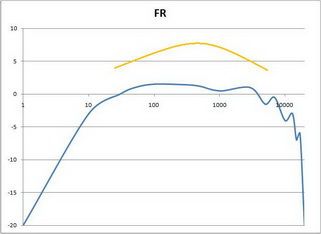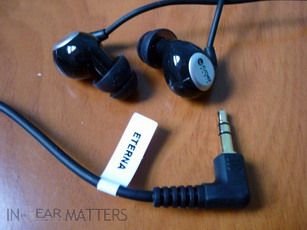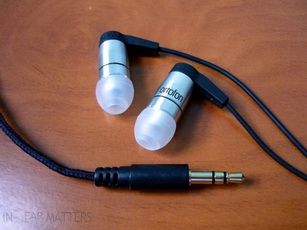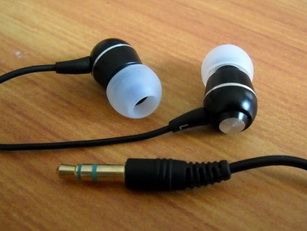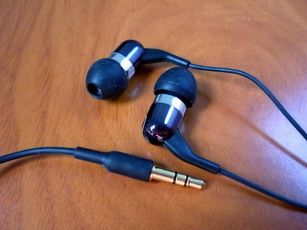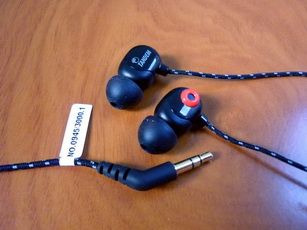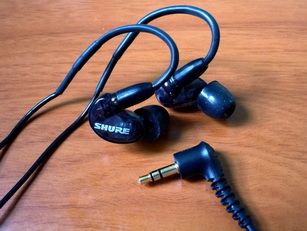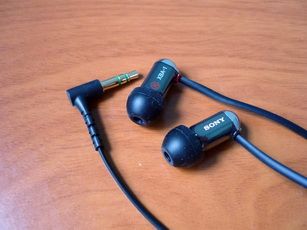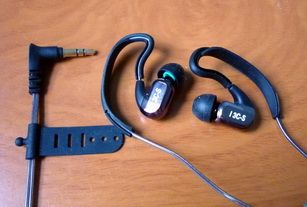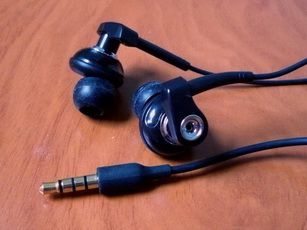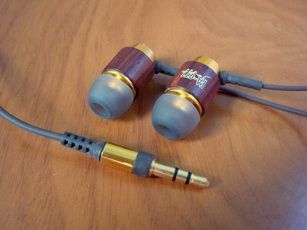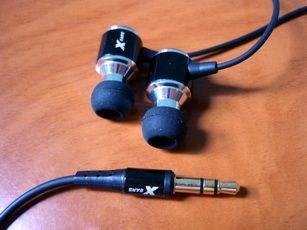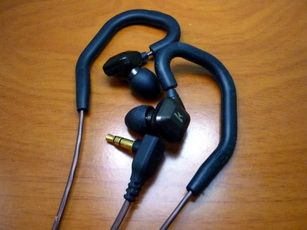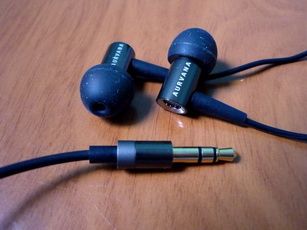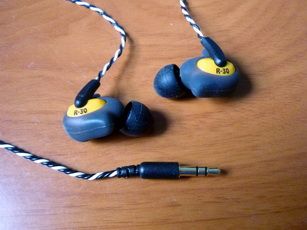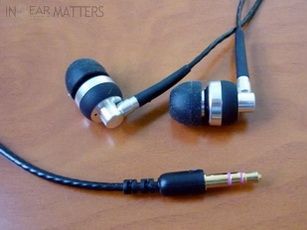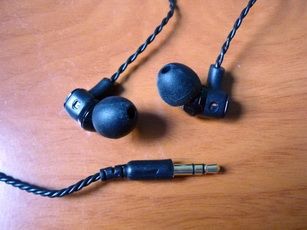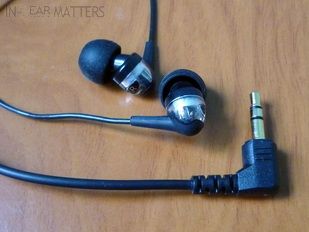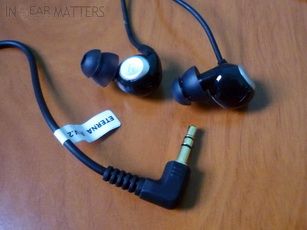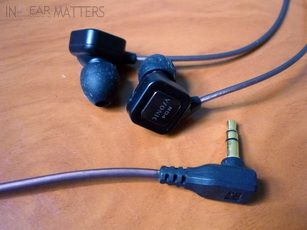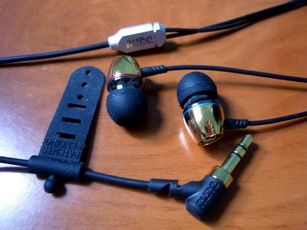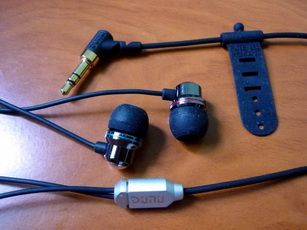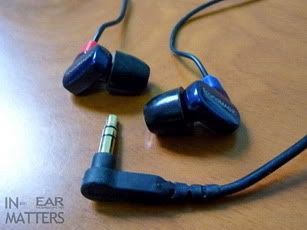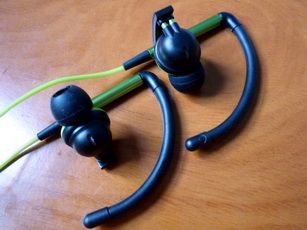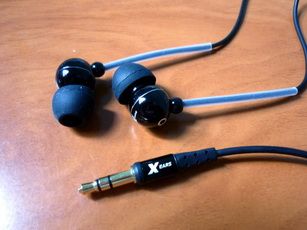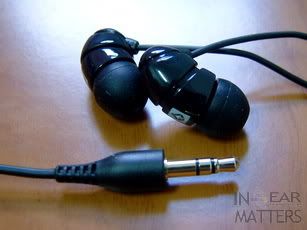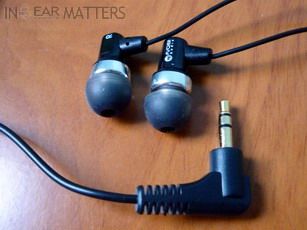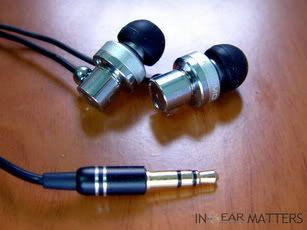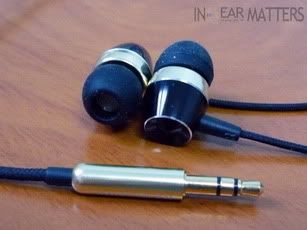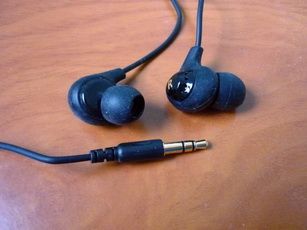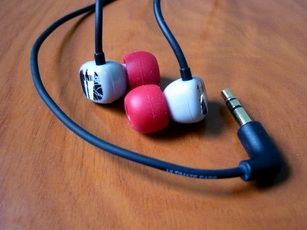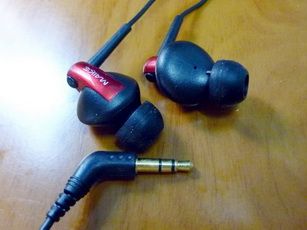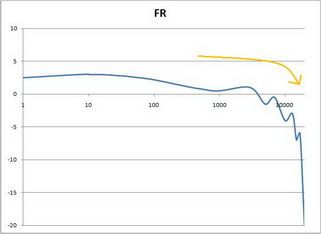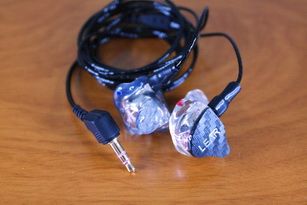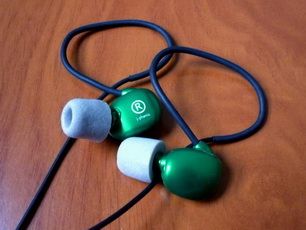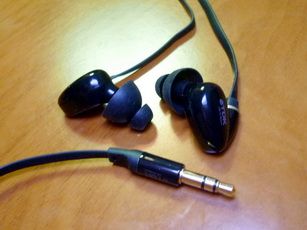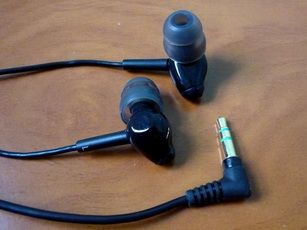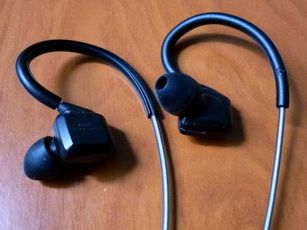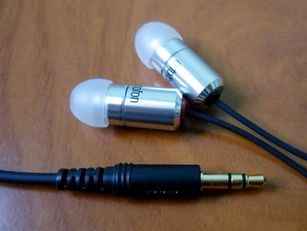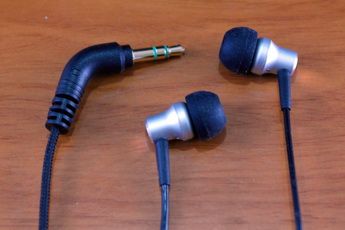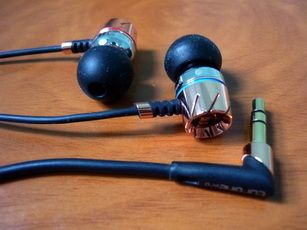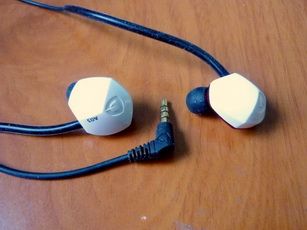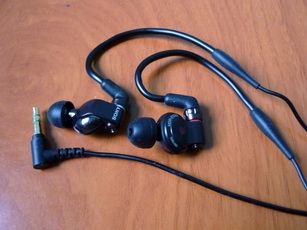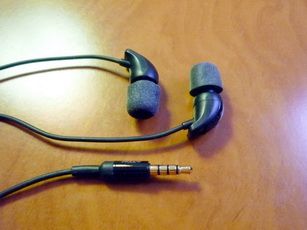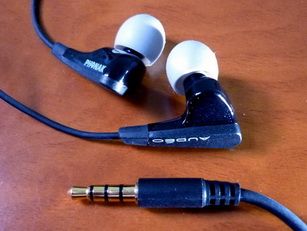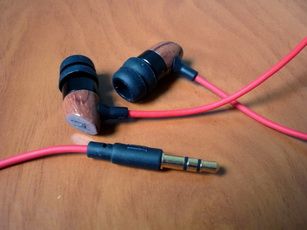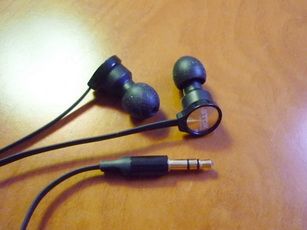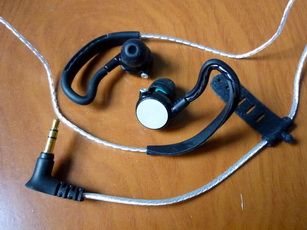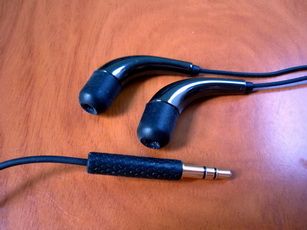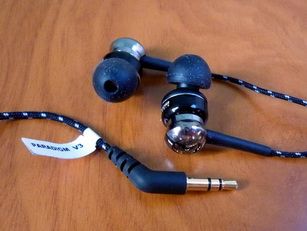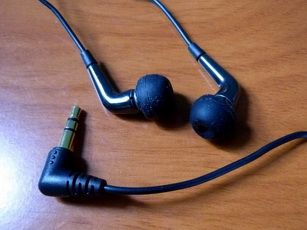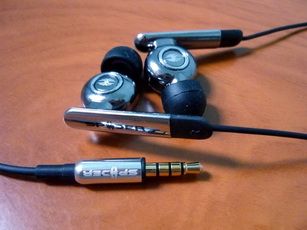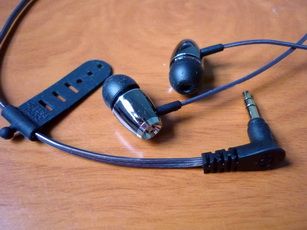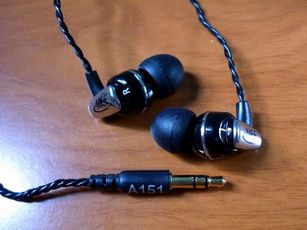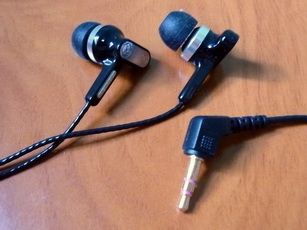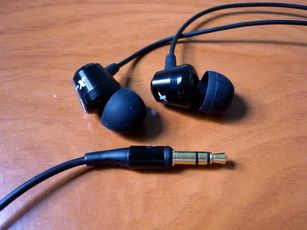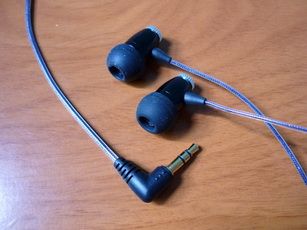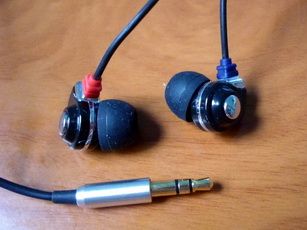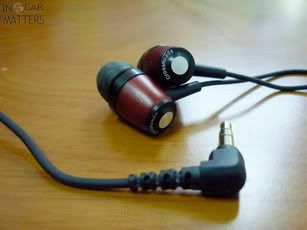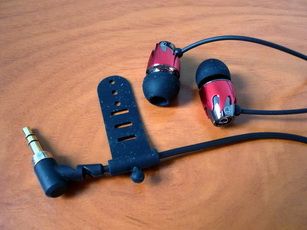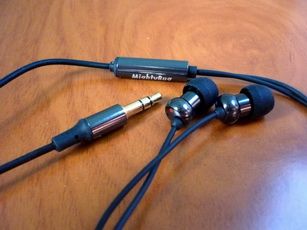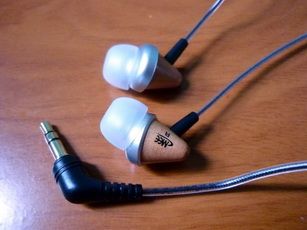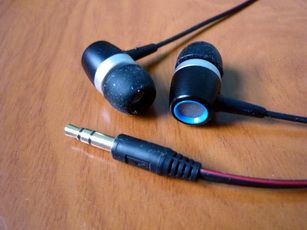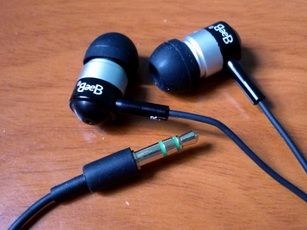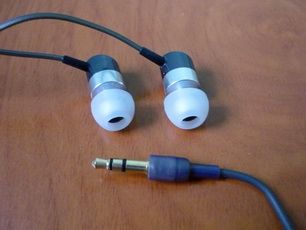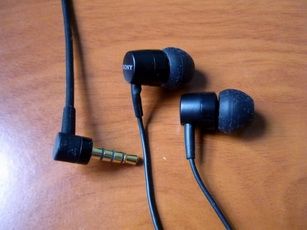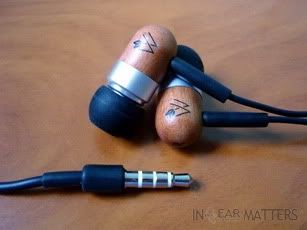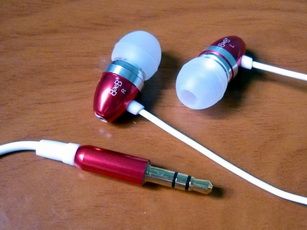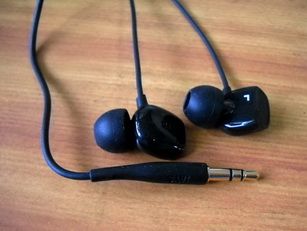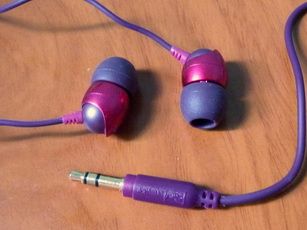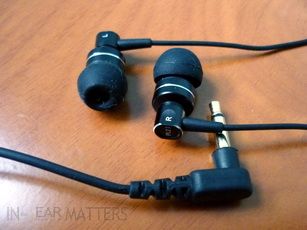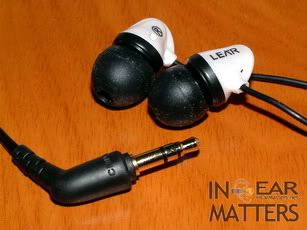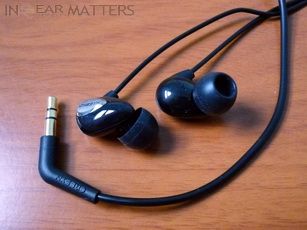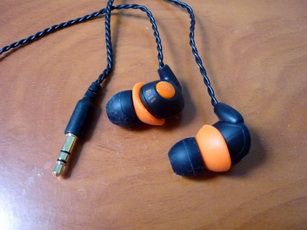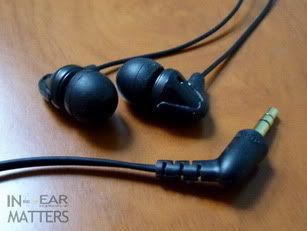Warm + Sweet
A warm and sweet sound signature is a cross between a bass oriented and a mid centric sound. Bass strong but not overwhelming while vocal is still relatively forward, though not particular detail in the treble. It is a sound that is generally recognized for being-nothing-wrong, but at the same time doesn’t have any particular strength.
1. LEAR LCM-5 (
link)
Warm, rich, well extended to both ends, and somewhere between stage-monitor-like and being musical with a smooth top. Bass is a bit more than neutral, but far from bass monster quantitatively. It reaches down to sub-bass, well bodied and textured with a good amount of impact, and has a really good decay as well, almost like a good dynamic transducer. Mid is the center of the presentation as it is sweet, detailed, rich but not overly forward. It isn’t really a mid-centric sound as it is still in-line with bass as far as forwardness is concerned, but it is the liquidity in its presentation that draws the listener’s attention naturally and makes for a beautiful vocal that can even compared to mid-centric IEM. Treble is well extended as well, crisp and sparkly but it is half-a-step behind mid and bass. This gives it a sense of smoothness but not being veil in anyway. Micro detail is still all there, but they are not the focus. Soundstage is well above average but not the widest ever – more enveloping than it is open-ended, but with well rendered layers. Image and position suffer slightly due to the richness, but it is part of the appeal of having a warm sound and I don’t consider it a downside that much. With the Monitor Sound Tuned Adapter, LCM-5 takes on a different a different personality that is more neutral and reference flat in frequency response, almost like Etymotic ER4S with a richer body. The transformation with and without MSTA is somewhat similar to ER4S and ER4P, except it is more pronounced and doesn’t drop in SQ. Bass still extends down deeply, but along with the mid they both take a back seat to upper vocal and treble. The focus has shifted from the more stage-monitor-like to a more reference-analytical-monitor-like presentation. However, there is still a small amount of fullness left in the mid and bass so it isn’t particularly sterile or cold like an Etymotic. But the similarity in brightness and hyper-detailed presentation are an unmistakably sign that MSTA is meant to tune LCM-5 to be as accurate as possible. Besides being more accurate on the frequency response curve, one area of noticeable improvement is the soundstage. The original warmer, richer sound tends to cloud the image just a tiny bit by limiting how far the soundstage can expend. With the MSTA, the soundstage regains its open-ended definition.
Pro: Top-tier sound. Build quality.
Con: Cable might look underwhelmed at first.
2. j-phonic K2 SP (
link)
Neutral to slight warm, with an excellent end-to-end extension and tonal balance. While gently roll off at the sub-bass region, bass is still deep, impactful, well bodied, decayed and textured with quantity matching and the quality better of TF10’s dual woofer. Mid is also well textured, slightly sweet and upfront, keeping in pace with the bass while not overly done. Vocal shows just a fainted sense of intimacy but in just the right distance not to be in-the-face / too close. Treble is also in line with the rest of the frequency with an almost impeccable quantity and quality. Detail and sparkle is in the right amount not to make the IEM sounding bright or dark, overly analytical or feel the lack there of. Soundstage is above average, but not extremely wide. If there is a weakness that I was forced to accuse K2 SP for, it will be that it doesn’t render soundstage as great as the rest of its sound. It is still quite good, but it is in a small venue instead of a large theater.
Pro: Sleek, Build quality, Accessories, SQ.
Con: Price.
3. VSONIC GR01 (
link)
The other flagship from VSONIC. Warm and sweet sound, much like UE700. Treble extends just a hair better than UE700 and doesn’t feel lacking air. Very well behaved without any emphasis on brightness, aggressiveness or graininess while keeping a delicate balance between the warm+sweet house-sound and offering great amount of detail. However, analytical listener who are used to brightness probably won’t find it enough. Mid is clean and detail, slightly on the warm side but neither particularly upfront nor recessed. If anything, it has better texture and fullness than that of DBA-02 or B2, and even slightly ahead of UE700. Bass reaches down quite deep with decent quality but a little short on quantity. It comes slightly short in impact when compared to UE700 and needless to say, far less in amount and depth than that of GR07. Though the amount of bass isn’t much more than DBA-02/B2, it does have better texture and decay that gives it a more solid body. Soundstage is quite good. Not as wide as GR07 but has a better resolution and layer. Overall, the amounts of bass, mid and treble are in good balance and give GR01 a warm and slightly sweet sound signature that is tilting toward being neutral in presentation. It doesn’t quite have the kind of fun and dynamic sound that is found on lower end VSONIC. However, it is much refined – tight, detail, accurate, and very well controlled with a right mix of technicality and musicality, showing how careful tuning can push the limitation of the TWFK drivers. While GR01 does sound better than most TWFK based IEM, it doesn’t surpass GR07 by much – more polite and more balance technically, GR01 represents another highly tuned IEM that can be compared face to face to GR07 without coming short. Where GR07 excels in texture, bass and soundstage, GR01 excels in detail, control and linearity in frequency response.
Pro: Best sounding TWFK dual driver yet. Accessories.
Con: Slightly longish body. More expensive compared to other TWFK. Mcrophonics.
4. TDK BA200 (
link)
Warm and sweet like the rest of the TDK’s IEM family but comes in more of a stage monitor tuning that resembles the Westone UM series. Like any good monitor, bass comes in a fairly neutral flavor. While it is tight, it still runs deep, impactful and good in texture. More importantly, it does come out when it is called for and never feel lacking in anyway except for a basshead. Mid is sweet, but not overly full or particular upfront. It is well distanced, showing space between the singer and the listener while still warm and have a decent sense of intimacy and texture. Treble is well extended but in a smooth way. Delicacy and detail are kept in place by having just enough sparkles and crispiness. Overall, neither one particular element stands out on its own where the whole presentation is rich but not lush and make for both a good stage monitor as well as day-to-day IEM
Pro: Top-tier sound for a dual driver price. Build quality. Accessories. Not picky on source.
Con: Slightly big Y-splitter. Availability.
5. HifiMan RE262 (
link)
Warm, full, silky smooth yet articulated, full of texture and detail. Musical and sufficiently technical. Bass runs deep to the 10Hz region and doesn’t have any strange bump anywhere. The quantity is not large by definition, but comes with good texture, body and decay. Able to showcases the quality and present of bass, while does not overwhelm other frequency range. Mid range is the sweet spot of the whole sound. It is dominant but not overly forward; it is sweet but not overly full; it is textured, good in timbre and well spaced, which in term makes the vocal sounds effortlessly real, as if in live. Treble is crispy and decently extended. Not quite as detail as RE0 or ER4S, but it is not lacking compared to most other non analytical IEM. It is half-step behind the mid but still able to function as a good supporting role to the overall presentation. Most importantly, though overly smooth and sibilant-free, it remains edgy enough so it won’t sound dark. Soundstage is very well done - not endlessly huge, but it is very spacious, immersive, well placed and fairly 3D, which is something rare in a mid dominating sound. At first, RE262 might appear to be an IEM that only do well in vocal, but it is surprising adaptive. Granted that it might be a bit too thick for very fast music, it is quite well for Classical and most instrumental music as well, especially since separation and placement are really good on the wide soundstage.
[UPDATE] The final release of RE262 will have TRRS plug with various adapters.
Pro: One of the best dynamic IEM around.
Con: Amp to sound best.
6. VSONIC GR07 (
link)
Warm, remains fairly musical while keeping a good end-to-end extension in a fairly natural fashion. While there is still a very small hint of edginess in the lower region, treble is crisp and extended, accentuates the overall presentation by adding detail but does not stand out by itself. Mid is on the fuller side but not obviously forwarded or as sweet as R04 (from the same company). Instead, it focuses on presenting layers and texture, plus a good sense of space, separation and resolution. Bass is close to being neutral but it has very good impact and depth, especially since sub-bass is fairly well rendered. It complements the mid well but at the same time is able to hold up on its own. Soundstage is excellent - though better on the lateral with good separation than on portraying depth, thus not the best there is. GR07 is not a ‘wow’ type of IEM in first listen. Its strength lies within the control and refinement on presenting micro detail over the whole frequency range, while at the same time trying to be as natural as possible without stressing the listener. This allows for fatigue-free long listening session in low volume while not losing any focus – an excellent quality for stage monitoring, though could be considered as not being exciting enough or even boring.
Pro: Price. Good build quality.
Con: Availability.
7. Ortofon e-Q5 (
link)
Warm, sweat and smooth with a good sense of balance and detail, less mid focus compared to e-Q7. Bass loses a bit of impact and quantity from e-Q7, but gain better depth and slightly more texture. Mid is still sweet with good body but not quite as forward as e-Q7. While still a dominating factor in the overall sound, it allows the other frequency to play a bigger role. Treble no longer has the slight roll off at the top like e-Q7 but extends at a very smooth yet detail way, sparkly while not bright in any sense. Soundstage is also improved greatly over e-Q7. While it might not be a lot wider, it is airier, more transparent with better depth and layers. The moving armature transducer perfectly marries the technical side of an armature driver with the warm, lushness of dynamic driver.
Pro: Moving armature. Build Quality. One of the best sounding single armature IEM.
Con: Price. Fit.
8. HifiMan RE400 (
link)
Warm, calm, a sense of neutrality almost like a stage monitor while still has a good degree of musicality in its presentation. Bass runs deep down to the 20Hz region, well bodied and comes with good low end rumbling. It is however quantitatively only a bit more than neutral. Mid is sweet, detailed and textured. It is thick but not overly so, almost can be called a mid-centric sound if not for the well complimented bass. Treble extends high, but mostly in a gentle fashion so all the sparkles tend to be just half-a-step behind the rest of the frequency. Analytical listener need not apply, especially if you are a fan of RE272 or RE0. RE262’s fan on the other hand might find RE400 to be closer to their heart, but it doesn’t quite have the same euphonic feeling. Soundstage is above average but not excessively wide as the whole presentation is neither upfront nor very far away, rather it is immersive and surrounding like sitting in the third role of a small theatre.
Pro: Price. Best built in HifiMan yet. All-arounder sound.
Con: None.
9. Monster Turbine Pro Copper (
link)
Warm, sweet, full and smooth. Bass is hard hitting, deep, well textured but also well rounded and not overly aggressive. While not a bass monster in nature, it has the quantity that can easily put smile on a basshead and the texture, speed, and proper decay not to sound muddy. Mid is forwarded, but not overly full. It is sweet but not in-your-face, keeping just enough distance not to become mid-centric, yet gives a sense of intimacy in vocal. The mid and bass complement each other very well and do not overpower one another at anytime, making it the backbone of the Copper’s sound. Treble is well extended, but lacks just a tiny bit of extra sparkle on the top to fully showcase the crispiness of string or brass instruments on its own. As a whole however, the treble still acts well to accentuate the mid and bass presentation without appear to be lacking. Soundstage is only decent, as expected on a full sounding IEM and there is nothing to be faulted for.
Pro: Sleek. Accessories. Life warranty and one time free replacement.
Con: Eartips sizes, Driver flex.
10. Sony XBA-4 (
link)
Mellowed mid with a strong bass and better extended treble – warm, decently sweet, full bodied yet still good in soundstage. Bass reaches down to 20Hz easily, but deep end rumble isn’t very obvious due to the equally strong mid-bass region that gives more body than roar. Mid, as said, carries the same mellow’ish presentation that has good texture and detail but not particularly upfront. Treble extends all the way up and offer good sparkles and crispiness, mainly as a supporting role in the whole presentation rather than standing out as an element on its own. It can however sound a little metallic when the volume is turned too high. The good news is that it doesn’t have any sibilance issue at all, making it the first top-end Sony since EX700 that isn’t plagued by over-brightness and actually sounds rather smooth. Soundstage, like XBA-1, benefits from the same mellowed and laid back tuning and actually is pretty good as well. As a quad BA, XBA-4 technically isn’t quite as strong as other quad like the Westone 4 (which is almost US$300 more expensive). However, XBA-4 offers a very unique tuning of its own - reminiscence of a closed-back circumaural that is smooth, relaxing, and often musical – hours and hours of listening can easily go by without any stress on the listener, and that’s the strength of XBA-4.
Pro: Quad drivers. Build quality. First sibilance-less top Sony.
Con: Low impedance.
11. RedGiant A03 Ossicle (
link)
On the stock single flange, A03 is relatively neutral in FR curve with a slightly brighter upper vocal while the bass is a little short on decay, and thus a lack of body and texture on the lower end. On the big-flanges, the emphasis is on bass quality and quantity, but at the cost of an overly smoothed out treble. With the single flange from Atomic Floyd (which isn’t sold separately but only comes with AF’s IEM), it achieves the best compromise between bass body and treble detail. But even with different eartips, A03 is still a warm and specious sounding IEM, though more specious on the bi-flanges than on the single flange. It has the same musicality as A00, but technically much tighter. The only real weakness of the whole presentation is in the mid. While the main vocal region over 1kHz is decently forwarded, it does sound a little thin and lacking texture at the same time. The smoking gun seems to be pointing at a slight dip in the lower mid region, around the 450-500Hz area to be precise. A 2-3dB of boosting in this area is all it takes to add back the texture and makes vocal beautiful again. Overall, A03 is one of the better sounding dual dynamic in the market and rival that of Radius DDM2 with a more balanced presentation. However, it does take a bit more effort to get the ideal sound out of it.
Pro: Build Quality, Price, Accessories.
Con: Fit.
12. Sony MH1C / Sony Ericsson MH1 (
link)
Warm and sweet, and well balanced in all frequencies. Bass extends down to 10Hz and hits with really good quantity and quality. Not the fastest or biggest impact around, but nothing to be ashamed of even among bass monster. Mid is sweet and right in the butter zone to give the right balance of intimacy and texture while still maintains a good sense of layer and space. Treble extends up to the very top, but it is more about smoothness than it is brightness. While analytical listeners might not find the sparkle or crispiness to be enough for their taste, it still however compliments the mid and bass impeccably and doesn’t feel lacking in anyway. Soundstage is rather good. By no mean the best of the best or endlessly large, it does portrait width and depth in a very 3D, well layered and resolving manner within its own confine. An excellent multi-genre all-arounder.
Pro: Price. Build quality. Even better value than EX600.
Con: Flat over-the-neck asymmetrical cable design.
13. Sunrise Xcape Impressive Edition (
link)
Warm, sweet, full and smooth. Bass is full, punchy, well bodied though misses some of the really deep note. It is a good balance between quantity and quality and should be quite satisfiable except for the most serious of bass addict. Mid is a little on the lush side and more rounded but slightly less textured compared to the original Xcape. It takes away a little of the technicality but adds back some intimacy and richness to the mix. Treble, while still decent, takes a step back on the whole presentation. It has the same sparkle, but in smaller scale and doesn’t sound quite as crisp as the original Xcape. While not totally lacking in micro detail, it is not quite analytical. The overall sound has shifted from the original Xcape’s upper-mid-lower-treble’s detail to more of a lower-mid-upper-bass’s texture. Soundstage is above average. It might not have the same dark background as the original Xcape, the overall positioning and imaging are improved and feel less 2D.
Pro: Better sounding than the previous Xcape v2.
Con: Nope.
14. Sony MDR-EX600 (
link)
Warm, laid back and specious. Bass extends the rather deep to the sub-bass region with good texture, but quantitatively only above neutral and not large by any mean. Similar observation can be said on the mid as well – good detail and texture but not particularly upfront or sweet. This gives a presentation that is well controlled and fairly neutral, but at the same time more laid back and specious. However, upper mid (especially female vocal) is grainy, but not edgy or sibilant. Treble rolls off a bit too early on the top, missing some of the top-end sparkle beyond 15kHz. Despite these nuisances, the IEM still maintains a good balance in frequency response. The mid-to-bass performance is what winning the show. While upper-mid to treble isn’t exactly bad per se, those who pay attention mostly to female vocal or crispiness in violin and cymbal might not find the EX600 best of choice. On the good side – the lacking of isolation (which grants better openness) plus the overall laidback presentation gives the IEM a really good soundstage, even though the transparency is slightly hindered by the lack of air beyond 15kHz.
Pro: One of the best valued dynamic IEM Sony ever made. Accessories.
Con: Availability in the West. Fit. Isolation.
15. TDK EB950 (
link)
Warm and sweet sounding with a fairly strong lower end response. Bass can be slightly boomy at time but not aggressive. It can almost be classified as being bass dominated if not for the equally dominating mid range. Together they complement each other and present a sound that is fun and energetic. Treble, while not lacking, is a step behind the mid and bass. The light amount of sparkles adds detail to the overall sound but not an element of its own. While analytical listener would probably find it to be insufficient, casual listener will likely to enjoy the blend that is forwarded, dynamic, musical and fatigue free. Soundstage is about average, neither good nor particular bad in any aspects. Overall, EB950 is a high energy and easy-going IEM to listen to and best suited for casual listeners who are looking more for enjoyment rather than technical accuracy. As such, it is probably most suitable for more mainstream music as well. While it might not be the most accurate sounding IEM in the sub$100 market, it still compares really well to other popular choices in the same bucket such as HifiMan RE0 and Shure SE215.
Pro: Price/performance ratio.
Con: None.
16. Phonak Audéo PFE 022 Perfect Bass (
link)
Very warm, smooth, musical and even a little dark. Almost a classic bass oriented sound if not for a decent mid. Treble extends fairly well, but very smooth. Sparkles and crispiness still present, though taking a big step back behinds the mid and bass. Mid has full body but not overly done, giving sweetness to the vocal while still maintain a decent sense of layers. Bass has good quantity and quality – it reaches very low, almost big enough for bass head, yet still well textured and fairly impactful, though just a tad slow for balanced armature (but perfectly fine when compared to most dynamic based IEM). Soundstage is a little below average, no doubt a trade off for the added warmness. Compared to the original PFE with black filter (which is more musical, bassier of the two original filters), the big difference is on the bass region. It has a much more textured and bigger bass to support the vocal. But there are downsides as well – compared to the open sounding grey filter and the musical while still fairly balanced sounding black filter, the perfect bass green filter sounds more compressed, losing a bit of resolution and dynamic range at the same time. Another more minor downside it requires just little more volume compared to the original PFE as the new green filter adds a little more acoustic impedance to the IEM and lower the sensitivity a bit (though it is not listed on spec). Still, if you were to consider the Perfect Bass series as an independent product of its own at its targeted price range, the overall performance is very admirable.
Pro: Price. Upgradeable to original PFE. Comfort. Two years warranty.
Con: Availability. Accessories compared to the original PFE.
17. HiSound Audio Popo (
link)
It is hard to define how ‘woody’ sounds like by words, but there is always a sense of lushness caused by reverberation of the wooden IEM housing that are pleasing to the ears, though it might not be the most accurate sounding. Like many woody IEM, Battleflag (Popo) carries the lushness of the wood into its warm and sweet sound signature. While it is quantitatively above average, bass can often be boomy but shallow in depth. However, it is not boomy enough to be offensive and in fact, quite enjoyable for casual listening. Though it is classified as being sweet sounding, the mid isn’t particularly forward. It has enough warm and thickness to keep pace with bass and give it some sweetness, but back away enough to reserve a sense of space between the signer and the listener. Treble has good extension but missing some of the top end sparkle – not something very noticeable unless you are looking for it. It is decently crisp but overall smooth and tends to trail behind the mid and bass. Soundstage is pretty good, airy, specious but more immersive than it is transparent. Technically, Battleflag is not strong in any particular area. But as a whole, the sum is larger than its parts. It is rich, it is lush, and most importantly, it is fun and relaxing to listen to.
Pro: Price. It sounds much better than its name.
Con: Name. Lack of chin slider. Very mild driver flex.
18. HifiMan RE1 (
link)
Slightly dark by itself but very smooth, musical and forgiving, must be amped well with a fast and detail amp or a clean, digital sounding source to reveal its potential. Treble, when amped well, is smooth but still decently revealing with a small hint of sparkle. Mid is a bit of the lush size, full but not thick, sweet but not veil. Bass is not big by quantity, but flow with the mid with a good body. Soundstage is natural and wide. Overall a very relaxing, laid back presentation.
Pro: Lush and euphonic.
Con: Amping needed. Quite source dependant. Isolation.
19. TDK BA100 (
link)
Warm and sweet sound, but almost on the opposite end on presentation in comparison to the lively EB950. Technically perhaps slightly more accurate than EB950, BA100 lacks a sense of dynamic and musicality. Bass is slightly higher in amount than being neutral, neither particular deep nor impactful. It is however well in line with the mid, in a fairly unremarkable way no less. With the treble mostly smoothed out and lacking of good sparkle and crispiness, the overall sound is on the thick and slow side, blurring out some of the lower end texture. The whole presentation is overly compensated to a point where smooth becomes BA100’s only flaw, as the life and edge of the music are sucked out from the sound itself and all it left is a sense of veil, almost like listening to an old Shure model. Due to the lack of air, soundstage is only below average. At this point, you might start asking whether BA100 is really that bad? No. It is still technically better than a lot of lower end single balanced armature IEM. However, it definitely comes short when compared to other good IEM within its MSRP of $200. The good news is that the street price is so low these days (as low as $50 on Amazon), it still makes for very a decent choice.
Pro: Low street price. Build quality. Accessories.
Con: Scary MSRP. Earpieces are on the large size.
20. Dunu Tai Chi (
link)
Being a tunable IEM, it has two faces: with the bass port sealed, it is has a warm yet fairly neutral presentation; with the bass port opened, the bass starts to steal the show. Beside the different of bass, lower treble / upper mid can be tuned by using either the included Sony Hybrid clone (less) or the grey eartips (more). Since the difference isn’t nearly as significant as the bass port, the grey eartips is simply a no-brainer for giving just a tad more micro-detail. Upper treble is mostly unaffected by eartips and has good extension and sparkle. It isn’t exactly analytical but doesn’t feel lacking either. Mid on the other hand stays relatively clear regardless of what bass port or eartips configuration are used. It isn’t particularly forwarded, but stays in line with the rest of the frequency response and therefore doesn’t sound recessed. Soundstage is above average with good instrument separation. As the flagship, Tai Chi is not only the best sounding IEM DUNU ever made, it is probably the best balanced sounding IEM in the whole line-up as well. It plays with almost every genre of music, even though it might not excel in any particular. On the other hand, this maybe Tai Chi only weakness as well Already an excellent all-arounder, what Tai Chi needs is one edge that set itself above and beyond other IEM around the same price range.
Pro: Build Quality. Accessories. User Tunable Sound.
Con: Tiny damper.
21. Fischer Audio Ceramique (
link)
Warm and sweet, not nearly as crisp but grander overall. Bass reaches down deep and a little boomy around the 250Hz region. While it is quantitatively above average, it is neither particularly fast nor hard hitting, but good in presenting body and depth which let the slight bass bleed acceptable. Mid is warm, sweet and on the full side. Like CC51, it is distanced but not recessed and has a better sense of space and layer. Treble is well extended but a step behind the mid and bass. While it might not be as crisp as CC51, the amount of detail and sparkle are still enough not to feel lacking. As like treble in CC51, it acts more as an accentuation rather than an element of its own, though milder in presentation and gives a smooth and cozy impression. Soundstage is rather good even with the slightly boomy bass as the overall presentation feels grander than that of CC51 yet still remains intimate. Despite suffering from issues on build and design, Ceramique is still able to hold up on its own in sound quality. The warm and cozy sound signature is particular good for a laid back, relax listening session.
Pro: Ceramic housing
Con: Weight. Poor cable design. No left /right mark. One size fit all eartips. Not for small ears.
22. Fischer Audio Paradigm v.3 (
link)
Warm, sweet, full and smooth. Bass is not large but has good depth, body and decent hit when called for. Mid, like X-IE, is lush and well rounded but more upfront. Not the best textured vocal but it is smooth, full and intimate. Treble has good sparkle and detail but a half step back behind the mid, lacks the up most crispiness. Soundstage is decent. Not quite as airy as X-IE due to the more forwarded mid, but it becomes more enveloping. While Paradigm v.3 also has a kind of relaxing sound as Ceramique, the main difference is that Paradigm v.3 is more neutral in presentation and thus ever slightly more laid back that the fuller / lusher sounding Ceramique. While both will make great choice for fatigue-free listening, Paradigm v.3 perhaps is better for care-free / background listening.
Pro: Microphonics.
Con: Housing can be slightly large.
23. Sunrise Xcape v2 (
link)
Warm and smooth with a sense of thickness. Bass is quick and impactful with a very decent quantity, but lacks just a tad of depth on the lower end. Mid is slightly further away but not being recessed, full and resonating which gives a sense of thickness and makes the mid sounding a tad lazy and veil. Though extends decently, treble is overly smooth and lacks sparkles, steering the overall presentation slightly toward being dark. Soundstage is decent but limited by the thick mid and smooth treble, where air is lacking.
Pro: Improved build quality.
Con: Not quite as good sound as the original Xcape.
24. Xears Turbo Devices TD III PRO Blackwood (discontinued) (
link)
Warm and sweet like Resonance, but cleaner, better extended, more dynamic and livelier. Bass reaches down deep to the 10Hz region with good quantity and quality. Unlike Resonance, which is more mid-bass than anything else, TD III PRO shows proper rumble and decent texture. Not a bass monster per se, but enough to put smile on your average bass seeker. Mid is warm, sweet and full of texture, good in vocal but not overly so to sound like mid dominance. Treble is well extended to 16kHz, just shy of XR120PRO II but still the second best in this review. It is crisp and sparkly, just doesn’t sound quite as clean and detail as XR120PRO II and has a tiny bit of edginess in it. If we were to consider the overall presentation however, the treble on TD III PRO is better balanced with the rest of the frequency. Soundstage is better than average and matching that of XR120PRO II. While XR120PRO II offers a more open and specious feeling, TD II PRO is more immersive with better layering and distance. The strength of TD III PRO is in its presentation - lively, rich and fun to listen, easily one of the best sounding IEM with wooden housing. This model has been discontinued and replaced by the TD III Pro v2 which has fabric sleeve cable and improved build quality.
Pro: eBay price. Wooden housing.
Con: High MSRP. Build quality.
25. Brainwavz M5 (
link)
Sound signature wise, M5 is warm and sweet with good extension on both ends, like a mid forward version of the M4. Bass is big and well extended to 20Hz, but the boominess on the upper bass somehow shadows the lower end texture and body, making the overall bass notes sound shallower than it actually is, sounding more fun and punchy rather than deep and rumbling. Mid, though more forwarded when compared to the M4, isn’t nearly as colored or in-your-face-sweet as the older M series (M1, M2 and M3). It is quantitatively more neutral in comparison, but still comes with really good detail and texture to stand firm to the bass rather than get flooded. Treble is where M5 shows the most resemblance to M4. It is well extended, crisp, detailed but not edgy. The only part it doesn’t measure up quite as good is in the overall clarity and micro-detail retrieval. Still, it is a very major step-up over the older M series in these areas. Soundstage is fair, decently wide and airy but nothing spectacular.
Pro: Built quality. Price. Accessories.
Con: None.
26. MEElectronics CC51 (
link)
Warm and sweet with a slightly crispy treble, perhaps a blend of all the good parts from CX21 and CX31. Bass is decent in both quality and quantity, with a balance of speed, impact, decay and body. If any, it can be slightly boomy at the 250Hz region, but nothing offensive. Mid is warm, sweet and slightly on the full side. Slight distanced but not recessed. It has a good sense of space in the presentation thus doesn’t become overly thick because of the fullness. Treble is a tiny step behind in the whole presentation but still provides a very good amount of sparkle and crispiness. It helps to accentuate rather than try to dominate, giving detail but in a gentler fashion. Soundstage is also intimate and decent, though more in height than in width or depth.
Pro: Sleek. Ceramic housing. Build quality.
Con: Not for small ear canal.
27. Spider realvoice (
link)
Very warm, sweet, relaxing yet not laid back and with a smooth upper end. Bass hits hard and has a full body. It can get slightly boomy at time which results in texture lost, but overall it remains in relatively good control and doesn’t become muddy. Mid is the strength of the overall presentation, pairing well with the bass but not overly done. It is warm to almost lush, sweet, intimate, well textured but not excessively up-front. It feels like the singer is right there with you, but not singing into your face or become overly vocal dominance that drowns out the small detail. Treble has sparkle, but small in amount and takes a step back in the overall presentation. It rolls off just a bit too early at 15kHz, but the lower end of the treble is able to maintain just enough micro detail not to feel overly smooth or totally lacking. However, the lack of upper extension translates to the damping of transparency and air. Because of that, soundstage is a little below average, which is not something uncommon for a very vocal centric sound. Coloration is really the key with realvoice. While there are other IEM in the same price range that are technically better or even a few that also do vocal quite well, the realvoice is really able to standout on its own by offering a distinct vocal that is relaxing, warm-and-fuzzy to a point of almost euphonic. It is the kind of IEM that wants you to listen to the music instead of listen to the IEM – and realvoice is doing a good job at that.
Pro: Build quality. Sleek. Vocal.
Con: Might not be best for non-vocal music.
28. DUNU Crater (
link)
Warm and sweet, neither forwarded nor laidback but with a slightly excessive feeling of weightiness due to mid-bass. Bass runs deep with good control and decent impact, but the upper region around 500Hz to 1kHz is a few dB too high – not as much on creating boominess but it muddies up the lower vocal noticeably. Mid isn’t forward in nature but it is clean, and somewhat bland. Treble extends well, but overly smooth after 12kHz so it lacks a sense of air. The lower treble region is also slightly grainy. Soundstage is decent, but nothing to write home about. For all its weaknesses, the IEM doesn’t have much of any major flaw. It compared well to many sub-$100 IEM like GR06 and Siren based single BA IEM such as the Sherwood SE-777 or MEElec A151. With a little EQ to reduce mid-bass and boost the upper treble, it can even edge out on most of them.
Pro: Build Quality. Accessories.
Con: None.
29. Astrotec AM90 (
link)
Very similar to both A151 and SE-777, but with better soundstage. Very warm and fairly musical, with a full sounding mid and bass. Treble is clean, very well extended but smooth, capable of showing a good degree of fine detail yet it is not the highlight of the sound. Mid is warm and full, slightly forward with a sweet vocal. Bass is also warm and bigger than average body, but slightly slower than expected and do not have a very strong impact, not quite a bass monster and roll off at near 20Hz yet a very good performance (both quality and quantity wise) as far as BA based IEM is concerned. The main different between AM90 to SE-777 or A151 is soundstage, which is noticeably wider than the later two. Though the soundstage has been improved, overall it is still relatively minor. While I do prefer AM90 a bit more, it is still more or less on the same level as SE-777 and A151 as far as technical ability goes.
Pro: One of the best sounding Siren IEM. Build Quality. Accessories.
Con: None
30. MEElectronics A151 (
link)
Very similar to SE-777 in overall sound - Very warm and fairly musical, with a full sounding mid and bass. Treble is clean, very well extended but smooth, capable of showing a good degree of fine detail yet it is not the highlight of the sound. Mid is warm and full, slightly forward with a sweet vocal. Bass is also warm and bigger than average body, but slightly slower than expected and do not have a very strong impact, not quite a bass monster and roll off at near 20Hz yet a very good performance (both quality and quantity wise) as far as BA based IEM is concerned. Soundstage is average due to the slightly forward mid, but there is still a good sense of airiness in it.
Pro: One of the best sounding Siren based IEM there is. Build Quality. Sleek.
Con: None
31. Sherwood SE-777 (discontinued) (
link)
Very warm and fairly musical, with a full sounding mid and bass. Treble is clean, very well extended but smooth, capable of showing a good degree of fine detail yet it is not the highlight of the sound. Mid is warm and full, slightly forward with a sweet vocal. Bass is also warm and bigger than average body, but slightly slower than expected and do not have a very strong impact, not quite a bass monster and roll off at near 20Hz yet a very good performance (both quality and quantity wise) as far as BA based IEM is concerned. Soundstage is average due to the slightly forward mid, but there is still a good sense of airiness in it.
Pro: Build quality. Price. Accessories.
Con: Eartips. Not for small outer ears.
32. Brainwavz M3 (
link)
Warm and musical, silky smoother in a more laid back manner with an emphasis on a more spacious presentation. Bass loses a little of its transient and attack from the M2, but increases in body and decay, giving a fuller and thicker impression but without being overly slow and muddy. Mid is full and sweet, yet seems to be slightly further away than M2. Treble is smooth and slightly roll off at the top. Too few sparkle and micro detail and gives a slightly darkish impression. Soundstage is decently big but also intimate at the same time. Switching from M2 to M3 feels like going from a big quiet open theater where the singer is right in front of you to a small venue or an old jazz bar where the singer is a couple of feet away. It is the same kind of warmish intimacy that surrounds the listener which is comfortable and relaxing.
Pro: Build quality. Replacement warranty.
Con: Not a major upgrade from M2.
33. Xears Resonance Black Edition (
link)
Warm and a little sweet, smooth and a little roll off at both ends. Bass has more than decent quantity, even has some happy (*not excessive) mid-bass hump but fairly well controlled. Though it doesn’t go very deep, the overall speed and decent decay make the hump rather enjoyable and not to appear boomy. Mid is overall smooth but has a fainted sense of warm and sweetness. It lacks good texture for vocal or forwardness but keeps just enough detail not to get totally overshadowed by the bass. Treble rolls off a little early just pass 15.5kHz, with enough sparkle to show some micro detail, but still smooth and far from being analytical. Soundstage is decent as the whole presentation isn’t particular upfront and the treble is just enough to keep a sense of air. Resonance is warm and sweet while close to being bass dominance. It is also musical and relaxing, making it a good IEM for laid back, late night casual listening without too much bothering into the technical aspect of the music.
Pro: None.
Con: No packaging.
34. MEElectronics SP51 (
link)
Warm and sweet with tunable bass. Bass, regardless of which bass tuning port, is able to show good quantity with very decent quality. The different bass tuning plate might make it slightly boomier or tighter, but it is still carries enough punch and texture not to be disliked. Mid has a sense of full and warmness in it. It is sweet but not overly done, forward but not in-the-face. Treble is decent and smooth with a fainted sense of sparkle, but half step behinds the mid and bass. Even with the silver port where the treble is most emphasized, it is still not enough to be a dominating factor in the overall presentation. Soundstage is decent and immersive, but not particular wide because of the warmness.
Pro: Tunable sound. Build quality. Accessories. Price.
Con: Driver flex
35. SoundMAGIC E30 (
link)
Neutral, slightly laid back, smooth yet retains a high degree of clarity and end-to-end reach. Bass reaches down almost as deep and decent in quantity. Not large by any means, but definitely much more than PL30 could have ever offered. Mid is not particular forwarded or recessed but feel like half step away, in the same room but not in-the-face. Treble is almost on the same pace as bass and mid in overall tonal balance, just a tad behinds but still retains good presence not to feel lacking. Soundstage is quite good. Not the best in positioning but still better than most in its price range. E30 resembles a little bit of GR07 – not quite as bright or as out reaching from end-to-end, but certainly has the same flavor of tuning toward a neutral, monitor-like presentation but with a tiny bit of added warm. This is not to say E30 can compete on or close to GR07 level just yet – it still doesn’t have quite as good a resolution. But for $40, the overall tonal balance of E30 is hard to beat.
Pro: Price. Build Quality.
Con: Could use a bi-flange.
36. CrossRoads Woody One (
link)
Very warm with big deep bass, full, upfront mid and a smooth upper end. Bass is big, deep, and slightly wet with a moderate attacking speed. Not really very refined but does retain enough control to not sound too boomy or muddy. Mid is full and upfront which tend to sound best with male vocal but not as well on female vocal. Upper mid and especially the treble sound pretty smooth without a lot of upper end sparkle and detail. No sibilance to speak of. Soundstage is slightly better than average and not as good as Woody Two.
Pro: Unique wood lushness. Wooden case.
Con: Large housing.
37. CrossRoads Woody Two (
link)
On the warm side yet still well balanced without any obvious flaw. Bass goes pretty deep but not as much as Woody One nor has its pronounced rumbling quantity. However, it does have a better sense of control in speed and attack. Mid is well balanced with a more upfront upper vocal (which is what makes female vocal sweet to listen). Treble is well extended with good highlight and sparkle which give great detail close to the point of being analytical. Soundstage is quite good and have a sense of airiness. Sibilance is minimum at worst and only very brief during the brightest passage.
Pro: Unique wood lushness. Wooden case.
Con: Large housing.
38. DUNU Hephaes (
link)
Warm and sweet as well, more forward and energetic than Trident but not overly so. Bass, like Trident, reaches down to the sub-bass level as well, but in smaller quantity and showing a much better balance and control. Mid is warm, more forward than Trident but not particularly full or sweet. It exchanges the fluidity of Trident and for better detail retrieval and texture, though also creates an annoying peak around 6kHz that makes the vocal sounds just a little grainy and edgy. The treble, like Trident, is smooth, well extended and in hiding. It can really use more sparkle and forwardness for micro detail. Soundstage is a little better than Trident, but overall still remains mostly average. Though it has better width, it just lacks air to breathe the sense of space into the music. All in all, Hephaes is technically a step up from Ares and Crius, and most certainly from Trident – but with a price. It is noticeably more edgy and restless, forgoing the easy going nature of the rest of the DUNU line-up and feels more like overreaching at times. But with a little damping in the 6kHz region in the EQ and treble boost for above 12kHz, Hephaes will shine.
Pro: Build quality, Accessories, Sleek.
Con: Price.
39. Fischer Audio Mighty Bug (
link)
Warm, full, rich and smooth sounding. Bass is just a tad on the boomy side with good quantity and decent quality. While it reaches down really deep, most of the time it is the upper bass that is a little over dominating and lose out some of the texture. The same fullness also extends upward to the mid, which gives a rich tone to the vocal though fortunately, not at the cost of making vocal muddy. Treble extends decently to near 16kHz, shows sparkles but smooth overall and lack a sense of crispiness. Soundstage is only average. The fullness on the bass and low mid and the lacking of air on the treble limit the feeling of space, though not bad enough to make it sounds 2D. Might Bug is pretty much a smooth and fun sounding IEM that pairs well with colder sounding source like iPod, tailored more toward the younger generation.
Pro: Tiny.
Con: Not for big ear canal.
40. VSONIC GR02 Bass Edition (
link)
Somewhat misleading name that would trick a person to think that it is the old GR02 with more bass. While it is true that the IEM does have more bass than the regular GR02, the improvement in bass is in offering more body and texture. The overall depth and impact are rather similar between the two. Abundant in bass? Yes, but not bass monster just yet. The biggest improvement comes in a more upfront mid and a well extended treble, giving it the same GR99’s sound signature that is warm and fairly equal in all frequencies. The improvements from GR99 to GR02 Bass Edition are better dynamic, richer tone and overall better detail. Nothing night and day, but still noticeable in direct comparison. This makes it almost as good sounding as GR04 even though it lacks a single big wow factor. Soundstage is decent as well, just nothing special to write home about. Like GR99, the versatility of the sound and lack of any particular weakness are GR02 Bass Edition’s greatest strength.
Pro: Price. Accessories.
Con: None.
41. MEElectronics CW31 (
link)
Smooth, musical with a warm and sweet sound. Bass extends slightly further than CX21 but features a slower speed and softer impact. It is however better on the decay and body. Mid is about the same as CX21, neither too forward nor too far away. The difference is in the slight sweet and lushness that makes CW31 a tad better at portraying a singer. Treble is smooth and rolls off gently. Sparkle takes a back seat but not overly lacking. Soundstage is slightly intimate and decent, though nothing to write home about.
Pro: Wooden housing. Build quality.
Con: None.
42. VSONIC R02 Pro II (
link)
Warm, smooth, fairly musical with a better than average soundstage. Treble has decent extension, but in a fairly smooth fashion and lacks the top sparkle to show off fine detail or give better resolution. Mid is slightly full, but not enough to show texture or being sweet. Bass has good impact and body, though not at the deepest end. Soundstage is good from side to side (width), but not airy enough to show true depth. It might not have the best of anything, but the overall blend doesn't have any major flaw as well. In other words, R02 Pro II has a rather 'popular' sound signature.
Pro: Price. Build quality.
Con: Isolation.
43. VSONIC GR99 (
link)
In comparison to R02 Pro II, the new GR99 is almost just as good – less warm and tighter in bass, more balance in overall presentation and better extended in treble. In short, it has a good portion of everything but not excessive in any. It still has the VSONIC’s warm and sweet house-sound, just less colored while still maintains a smooth and easy-going nature. Soundstage is quite decent, neither particular wide nor feel the lack of. Less fun sounding than R02 Pro II while technically more accurate, the great strength of GR99 is perhaps its lack of real weakness. For under $30 and a performance that ties R02 Pro II and DUNU Trident, you can hardly ask for more.
Pro: Price. Accessories.
Con: Microphonics.
44. Blue Ever Blue 868B Silver (
link)
Warm and sweet with an added layer of forwardness and thickness to the 866B that makes it more aggressive and upfront. Fuller mid, intimate vocal and crisp treble with the side effect of borderline sibilant in lower treble and overly thick bass note, which begins to interfere with the rest of the presentation. The fullness also reduces the sense of air and thus lowering the soundstage to about average. While overall performance going from 866B to 868B is positive, it pretty much is three steps forward and two steps back and thus not quite a significant upgrade as one might want it to be. More suitable to those who are really into full forward sound that has a strong rumbling bass. When EQ’ed however, there are still a lot of potential left by simply lowering the sub-bass level for 3~6dB.
Pro: None.
Con: Price. Build quality. Packaging.
45. DUNU Trident (
link)
Warm, sweet, laidback, smooth, easy going and musical. It is the kind of sound that draws the listener to the music instead to the IEM itself. Bass is hard hitting with a big body. It reaches down to sub-bass level easier but can get just a little overwhelming when it comes to bass heavy music as it lacks a very fine control and top speed. But overall the quality is still very good and should put smile for those who like a good dose of bass in the mix. Mid is warm and a little lush, but not particularly forward. It reserves some space between the singer and the listener, but pulls just a too far little away and loses some of the intimacy and texture in the vocal. While it is not as good as rendering vocal as Ares or Crius, the overall presentation is more relaxing and suitable for casual listening. Treble is well extended but smooth. Sparkle is small and micro detail, while not absent totally, is a step behind everything else. Soundstage is only about average. The laidback nature of the whole presentation gives a feeling of warm and intimacy without sounding too boxed in, making it a great choice for fatigue free, non crucial listening where music is to be enjoyed, not analyzed.
Pro: Price. Build quality. Sleek.
Con: None.
46. ECCI PR200 (
link)
Warm, but with a decent sense of balance and excitement. Bass extends deep but in a roll off fashion, but gone is the slight boominess in PR100, smaller in quantity but shows better control in comparison and maintains the same overall impact and texture. Mid is also presented very similar to PR100, slightly forward, decently bodied but not overly sweet, still gives a slightly mid centric impression but better in detail, separation and layering. Similarly, treble extends well in a roll off fashion though more forwarded, showing off micro-detail and sparkles which in term inject just the right amount of liveliness to the sound to give it a better balance in presentation without any major flaw. Soundstage is decent, with nothing to write home about.
Pro: Price. Accessories. Build quality
Con: None.
47. Sony MH750 (
link)
Same tuning as MH1, sharing an almost identical FR curve that is warm and sweet, though MH750 does sound a tiny bit darker. The overall refinement, air, soundstage, layer, position and resolution are however not as good on the MH750. A step down of the same sound basically. Soundstage is a little below average. Like EHS64#, not too shabby as free stock earphone for smartphone.
Pro: None.
Con: Cable could be better.
48. Woodees IESW100B (
link)
Warm side, slightly lush on the bass and mid region but still quantitatively balanced. Treble is above average but the slight harshness on 5kHz region can be a bit problematic on bright music.
Pro: Wooded housing.
Con: Need attention to small detail in build quality.
49. Blue Ever Blue 866B Red (
link)
Slightly warm and sweet yet remains fairly neutral with no particular emphasis on a certain frequency or the lack thereof. In fact, the end to end extension is rather good for IEM in such price bucket. Bass reaches deep and slightly on the thick side, quantitatively not monstrous but overall larger-than-average. Occasionally it can become slightly too thick (which reduces the texture and resolution) on bass heavy music, but it is still enjoyable and not too offensive. Mid is warm and slightly full, but not overly sweet or forwarded. Vocal is very decently textured while still retains a sense of space between the singer and the listener. Treble, especially lower treble and upper mid, is clean and clear, giving a rather good highlight over female vocal without sounding sibilant. Upper treble is however slightly rolled off. There is still some sparkle, but really lacks a sense of crispiness. Soundstage is quite good with a clearly defined sense of air, separation and image. It might not have the best soundstage in the sub$100 category but combines with the evenness of its sound signature, it is remarkably good for slow and relaxing music like vocal jazz.
Pro: Soundstage, Technical proficiency.
Con: Build quality. Packaging.
50. JAYS t-JAYS Two (
link)
Warm to slightly dark, lower mid centric, smooth and just a little laid back. Bass has good impact, decay, and quantity with decent control, though just a tad slow and doesn’t go quite deep enough. Mid is well bodied and render a sweet, but not too sweet of a vocal that is good in texture. Treble has sparkle but in much smoother fashion, rolls off just a little at the top end and misses some of the highest note, but nothing terrible. Soundstage is a little above average. Good for most vocal based music, rock and pop in general but still performs instrument and classical in decent manner. A decent choice over the now discontinued s-JAYS.
Pro: Sleek. Build Quality. Accessories. Warranty
Con: None.
51. EarsQuake SHA (
link)
Overall balanced, but more low mid forward. Bass is show very good impact, body and even a little bit of low end rumbling. There is still some hollow boominess left in the bass, but not very noticeable unless in high volume. Mid is a tad forward and has a decent sense of fullness, but lacks texture to make it really good. Treble has good sparkle and detail, smoother than the other two though still a little unrefined and does not quite have the top end extension. Still the presentation gives a good sense of airiness and space. Soundstage is decent at showing depth, but not quite as good on width.
Pro: Price.
Con: None.
52. SoundMAGIC PL21 (
link)
Warm to slight dark, musical, smooth, and has a small emphasis on the mid. Bass extends very deep, does rumbling sub-bass better than any IEM of its class while retaining very good control. Quantitatively not a bass monster but it does show a good bass impact and body. Mid is full, a little forward and vocal is sweet, no sibilance to speak of. Treble has a decent extension but lacks sparkle to show fine detail. Soundstage is about average.
Pro: Price. Build quality. Accessories.
Con: None
53. LEAR Le01 (discontinued) (
link)
Warm and smooth. Treble rolls off a bit on the top and doesn’t give a particular detail sound, though not totally lacking. Mid is slightly warm and has a small hint of sweetness, slightly distanced but not really recessed in any sense. Bass has a decent quantity though not very deep. Sound better with bi-flanges. Overall a done-nothing-wrong sound.
Pro: None.
Con: Strain relief.
54. ECCI PR100 (
link)
Warm, smooth and easy going to even a little laid back. Bass extends to quite deep in a roll off fashion, but neither too abundance nor short in quantity. It is however good in quality with decent texture and just a tiny but of boominess to give a sense of fullness, but not overdone in anyway. Mid is slightly forward, decently bodied but not overly sweet, just enough to show off detail and gives a mid centric impression without flooding the rest of the spectrum. Treble too extends well but in a roll off fashion, taking a step back from the mid and bass, resulting in micro-detail being really micro, but not totally lacking. Soundstage is a bit below average due to the warm mid.
Pro: Build quality. Accessories.
Con: None.
55. CrossRoads MylarOne Bijou 3 (discontinued)
Warm and fun sounding. Bass is a little slow, but decently bodied. Mid is a little away but not particularly recessed and still carries a sense of war, especially since lower midrange hump around 200Hz ~ 250Hz. Lower treble has sparkle, but rough in nature and doesn’t really able to reveal detail. Soundstage is only average
Pro: None.
Con: Require a lot of burn-in.
56. Hippo Epic
Warm, mid and bass centric, and not very detail, except Epic is more mid forward, grainier and less refined on the vocal and treble region, plus it is less punchy on the bass department and lesser in soudnstage. Overall, it is a more balanced sounding than Boom, but not quite as smooth sounding. Due to the slight mid forwardness, soundstage isn't particularly wide.
Pro: None.
Con: None.
57. Cresyn C230E (
link)
Warm, full, a little mid centric, sweet vocal, decent bass quantity wise and has enough detail not to sound dark or feel severe lack of treble. Soundstage is average. Overall an easy going sound aims more toward general consumer.
Pro: Price.
Con: Availability.
58. Rock It Sounds R-11 (
link)
Similar warm and laid back sound as R10, but less mid-centric in comparison. Treble still rolls off at the top end and so sparkle and air are both missing. Bass however extends a little better than R10 with sub-bass better rendered, even though quantitatively it is still less than neutral. Mid shares the same laid back, distanced fashion as R10, lacking detail and texture. However, there are lesser ‘disconnect’ between the mid and bass, so it is overall closer to more of a warm+sweet sound rather than a mid centric sound. Soundstage is below average as well. While R11 is priced just a little higher than R10 and spots a more neutral’ish presentation, the overall sound quality is still right around the same ballpark. It is more of a different in sound signature than in actual quality.
Pro: Accessories.
Con: None.
59. Brainwavz alpha (discontinued) (
link)
Slightly dark with a very mid and bass centric, fun and more personal sound. Big bass, heavy mid, and not very detail on the treble but still have a tiny bit of sparkle. Mid is slightly congested, but the bass has good resolution and texture. Vocal is pretty forward and dominant. Upper treble rolls off early. No sibilance to speak of. Soundstage is small due to the lack of fine detail and airiness. An easy going sound.
Pro: Not half bad for the price.
Con: None.
60. Creative EP-630
Very warm to dark and on the thick side. Bass is above average quantity wise and a decent impact and decay, but slow, lacks texture, and sound muddy overall. Mid is on the sweeter side, though not particular detail in any way. Upper mid / Lower treble is steely and rough while upper treble is overly smooth and lacking detail.
Pro: None.
Con: Price. A lot of fake.





